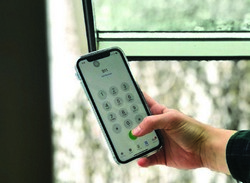As students and staff settle into their respective classrooms and offices on a typical school day, one may pull out their smartphone to peruse their social media feeds, check their emails, or text a friend.
Whatever the purpose may be, it’s not unlikely that poor cell service will get in the way of these tasks that smartphone users are so accustomed to. While it is easy to become frustrated with this issue, there is much more to this problem than meets the eye.
Jesse Denniston-Lee, a senior social work student and student resident, is all too familiar with the issue of cell service on campus. “I think it’s because of the enclosure. I think the fact that [the walls] are mainly brick based has something to do with the reception,” said Denniston-Lee in regards to the poor cellular service in his first-floor dorm room at Beachwood Hall.
Eric Reisher, Director of Broadcast Engineering and a Professor of Communication, also points to the development of campus facilities when asked about the cause of the issue. “The reasons for the poor coverage in most cases comes down to the construction of the buildings on campus. Arrays of concrete and steel help build strong buildings but block cell phone transmissions,” said Reisher.
However, the concrete and steel that make up the University’s facilities account for only a fraction of the reason for Monmouth’s poor cellular coverage. “Plangere and the surrounding area is in a zone where it is the furthest distance from surrounding cellular towers which creates a very weak zone for cell signals,” said Dickie Cox, an Assistant Professor Concentration Director of Interactive Digital Media.
“Those are not towers that the University has any governance over, but rather, mobile providers provide and maintain.”
According to Cox, this issue is something that the University has spent many years working with mobile providers to remedy. Edward Christensen, Ph.D., Vice President for the Information Management Department, says that he has directly dealt with this issue for a solid portion of the 10 years he’s held his current position.
“Most of our buildings are fairly close to each other, we put lots of people in them. So that doesn’t help anything. And then, you take simple geography, and you say, ‘Well, you can’t put antennas much farther east than us because they’d be in the ocean,’” explained Christensen. According to him, the nearest cellular towers are rather far-removed from the Monmouth campus; one tower being located at Monmouth Park Racetrack, and another at the water tower in Long Branch. One would have to travel to Eatontown or the Garden State Parkway before encountering another. “So, when you’re on the southwest corner of Plangere, the tallest tower [in relation] to us is the one at Monmouth Park which is just northeast of us, so on the southwest side you have to go building through building. So you just have weak signals; nobody wants a cell tower in town, and there aren’t any in West Long Branch,” explains Christensen.
During the construction of Mullaney Hall, Dr. Christensen oversaw the installation of an antenna-boosting system that was supposed to help the situation. Unfortunately, the system only helped marginally, and there was ultimately no noticeable improvement. “You can turn it on and off and it doesn’t change the signal much because the signal that’s going out is directed for a large area. It’s not directed at us, so it’s not a strong signal coming into one place,” said Christensen.
About three years ago, Christensen spoke with Verizon representatives regarding the installation of a distributed antenna system that would act as a real solution to the poor coverage on campus. Such a system would cost upwards of one million dollars to install, and the University could not immediately take on the project, according to Christensen. “Verizon came to us and said, ‘We have a problem,’” said Christensen. “Nobody wants to put antennas up, we have more and more people, we have more and more devices, everybody wants them to work, and they are having more and more problems keeping their people connected, particularly around making 911 calls.”
According to Christensen, the University is concerned that poor cellular coverage is a safety issue more than anything else, but the responsibility is ultimately on the mobile providers. “They’re the ones selling you a plan, not me,” said Christensen. According to him, the carrier’s initial solution was to utilize Wi-Fi calling, which wasn’t yet universal at the time Verizon approached Dr. Christensen about the distributed antenna system. If a Wi-Fi connection cannot be secured, however, Wi-Fi calling is impossible. “It was pretty clear that the real solution was gonna be the distributed antenna system, or simply to buy Wi-Fi bandwidth and just deal with the Wi-Fi part of it,” said Christensen. Shortly thereafter, Dr. Christensen agreed to the installation of Verizon’s distributed antenna system. “I said yes with the proviso that we were carrier-agnostic as a University,” said Christensen, highlighting that the University has no preference towards a specific mobile provider. Verizon agreed to these terms and the road to completion has not been without delay. “There have been all kinds of issues along the way, dealing with construction issues and so forth. If you were to walk over near McGill on the Norwood side of [McGill] Commons there’s a little out-cropping that’s been built there and that’s where the electronics for this system are in place, and as we speak, we’re starting to light up buildings on [Verizon’s end],” said Christensen. According to him, there are still a few buildings on campus that require maintenance before the new system is fully installed; namely Edison, Wilson, and the Pollak Theater area. However, the rest of campus is now equipped with the new system. “We went from having fewer antennas and access points to now, in many of the buildings, there’s an access point that is designed to handle 8 or 10 devices, in almost every other room,” said Christensen. The 705 new access points across campus will soon be operational. According to Christensen, the delay in activating the system has been due to a plethora of complex internal issues regarding construction, local bureaucracy, and working around the University’s academic schedule.
“We expect that by the early part of December, Verizon will be turned on across campus,” said Christensen. Unfortunately, students with carriers such as AT&T or T-Mobile will still be facing coverage issues, as other carriers will have to pay Verizon to use their system to improve their coverage on campus. “It’s still a work in progress in terms of all the other carriers coming online, but Verizon wants all the other carriers to come in because they’ll charge them,” said Christensen, who thinks the odds of these carriers coming online are generally high. “[It is] common in their industry for one carrier to build a cell tower and then invite the other carriers in,” said Christensen. According to him, T-Mobile has already approached Verizon about joining the new system. “That’s what I heard from Verizon, but until the system is up and running, [there is no telling] who’s gonna come in,” said Christensen.
The unfortunate reality of the situation is that cell service is a complex issue that is ultimately out of the University’s hands, according to Christensen. “It’s something where, to some extent, I don’t have a lot of control over [it] to where I can make things happen,” he said. “Honestly, more than once, I made the point of saying, ‘Y’know, [mobile providers] promise somebody coverage and then I deliver the Wi-Fi, which I pay for, to make your service work.’ It doesn’t make a whole lot of sense to me, but it is what it is.”
PHOTO TAKEN by Nicole Riddle



